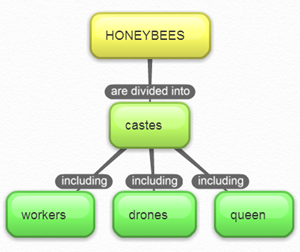ATD Blog
Science of Learning 101: Two More Instructional Strategies That Promote Sticking
Thu Feb 04 2016

In my previous post, I discussed that adults don’t merely absorb information that is presented to them during training.
Here's how it works: First, they have to interpret the information presented and figure out what parts are important. In other words, they need to find the relevant information. Then, they must organize that information into something coherent to them—organize it logically. Finally, they need to relate the new information to what they already know and integrate it into long-term memory.
The point: Instructional strategies that help learning “stick” must include connecting new information to what they already know. In that post, I discussed a sample activity that helps—have people summarize what they learned. Now, let’s review two more activities and applications you can use in typical organizational learning settings.
**
Building Concept Maps
**Concept maps can be used to show relationships between concepts. First, users present ideas, usually enclosed in circles. Next, concepts are linked by drawing a connecting line between circles. The words on the line identify the type of relationship between the concepts. Some examples of relationships might be: “leads to,” “is part of,” or “represents.” Some concept maps do not have relationship words on the line linking the words.

Concept maps can be drawn by hand, or they can be drawn with web apps or other tools, such as Cmap (cmap.ihmc.us), bubbl.us (bubbl.us), mindmeister (www.mindmeister.com), and coggle (coggle.it).
This figure offers an example of a start of a concept map about honeybees. It shows both the words and the relationships for the topic of “castes.” To expand the concept map, we could add sexes to the castes (workers and queen are female, drones are male, and then additional topics could be added, such as origin, species, lifecycle, bee products, and so on).
What makes concept mapping “sticky” for learning is that developing them helps people make sense of a specific topic by discerning and organizing relevant information. This helps users integrate new knowledge with what they already know (prior knowledge).
Here are a few ideas on how concept mapping might be used in synchronous and asynchronous training courses.
Synchronous: In a synchronous course, concept maps can be built individually or collaboratively. People can share maps and compare them for differences, including comparing them to an expert’s map. The instructor can ask learners to label lines between existing words. In other words, they can answer the question: How are nodes (words) connected? Another potential activity would be to leave certain nodes empty and to see who can come up with the right words.
Asynchronous: In an asynchronous course, you can build multiple-choice questions around correct and incorrect concept maps. For instance, the question might be: What is wrong with this concept map? Incorrect concept maps should contain typical misinterpretations. Very good feedback that explains why those typical misinterpretations are wrong should be provided—or you will have lost the opportunity to correct misinformation. In all cases, adequate feedback that explains why the correct answer is correct and why incorrect answers are incorrect is critical. Simply saying “correct” or “incorrect” doesn’t help provide enough information to help people learn. You can also have learners select labels for lines between existing words from among existing words.
Research shows that people do best with concept mapping when they have guidance in how to create them. Michael Zeilik, at the Department of Physics & Astronomy at the University of New Mexico, has a terrific handout on using concept maps as instructional activities.
**
Explaining Why
**Another good instructional strategy that helps learners connect new information to what they already know is explaining why. Building an explanation creates additional content, and this additional content improves understanding and recall.
What makes building an explanation “sticky” is that it requires figuring out what is relevant, organizing the information, and connecting it to what you already know to construct the explanation. Doing this integrates the knowledge with prior knowledge. Inferences have to be made. If good feedback is given, misunderstandings are corrected. (This is critical!)
Here are a few ideas on how explaining why might be used in synchronous and asynchronous training courses about food safety.
Synchronous: During a course on cleaning safety, for example, instructors can ask learners to explain the rationale behind the cleaning step for surfaces. Meanwhile, a partner could communicate if any vital information is missing in the explanation. They could then listen to an expert explanation and compare their explanations to the information from the expert.
Asynchronous: For an asynchronous course on cleaning safety, instructors can ask learners to select the correct diagram and explanation for the cleaning step for surfaces among three different diagrams/explanations. The wrong diagrams/explanations should be typical misinterpretations. Very good feedback that explains why those typical misinterpretations are wrong should be provided.
Granted, these activities are harder to develop than typical recall activities, but they help people learn more deeply. In the Comments below, please share what you think of them and how you might use them in your training.
Sources
Ainsworth, S. & Loizou, A.T. (2003). The effects of self-explaining when learning with text or diagrams. Cognitive Science 27 (2003) 669–681.
Freeman, L.A. & Jessup, L.M. (2004) The power and benefits of concept-mapping: Measuring use, usefulness, ease of use, and satisfaction. International Journal of Science Education, 26(2), 151-169.
Hausmann, R.G. & VanLehn, K. (2010). The effect of self-explaining on robust learning. International Journal of Artificial Intelligence in Education, 10(4).
Lee, H.W. Lim, K.Y., Grabowski, B.L. (2008). “Generative Learning: Principles and Implications for Making Meaning.” In J. M. Spector, M.D. Merrill, J. van Merrienboer, & M.P. Driscoll, (Eds.) Handbook of Research On Educational Communications and Technology (3rd ed.). (pp.111-1240. Mahwah, NJ: Lawrence Erlbaum.
Novak, J.D. & Cañas, A.J. (2006) The Theory Underlying Concept Maps and How to Construct Them, Technical Report IHMC CmapTools 2006-01, Florida Institute for Human and Machine Cognition (IHMC).
